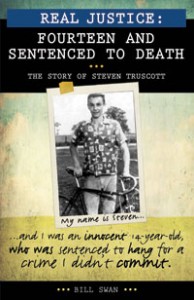Years ago, my husband and I saw the documentary Paradise Lost: The Child Murders at Robin Hood Hills, about three teenage misfits in West Memphis, Arkansas who were accused—and then convicted—or the grisly murder of three eight-year-old boys. Two of the boys, Damian Echols and Jason Baldwin, were fans of the heavy metal group Metallica, and their musical choices, dark clothing, rebellious behavior, and working-class backgrounds contributed to the belief that they killed the boys as part of a Satanic ritual. Eighteen-year-old Echols, believed to be the ringleader, was sentenced to death; the sentence was later reduced to life in prison.
Eighteen years and two follow-up documentaries later, DNA evidence exonerated the three men, and they were released. As the new Real Justice series from the Canadian publisher Lorimer shows, the experience of the West Memphis Three was far from the only time teenagers were convicted of murders they did not commit—and the United States is not the only industrialized democracy where these travesties of justice take place. Lorimer’s Real Justice series explores five cases in Canada: the sentencing to death of 14-year-old Steven Truscott in 1959 for the murder of a 12-year-old classmate; the conviction of social misfit Guy Paul Morin for the murder of a nine-year-old neighbor (the first time DNA evidence was used to exonerate someone convicted for murder in Canada); the meting of a life sentence to troubled teenager David Milgaard for the murder of a 20-year-old nursing student (the real murderer was later found); the conviction of university student Robert Baltovich for his girlfriend’s disappearance; and the conviction of a Mi’kmaq teen, Donald Marshall, Jr., who became an activist for indigenous rights following his exoneration.
 Lorimer sent me a review copy of Fourteen and Sentenced to Death: The Story of Steven Truscott. Author Bill Swan draws from trial testimony but states that in some places he has recreated dialogue “to improve context and narrative flow.” He presents Steve as am agreeable, friendly boy, large for his age and more interested in playing outdoors than paying attention in school. Steve was the last person to have seen Lynne Harper before her body was found, sexually assaulted and strangled, in the woods. Steve had given her a ride on his bicycle to a highway so she could hitchhike somewhere, possibly to a relative’s, following an argument with her parents. Swan portrays Steve during the investigation and trial as someone who could not believe anyone would accuse him of the crime. His and his parents’ faith that he would be cleared parallels that of Echols and Baldwin, who did not take their trial seriously and waived some important legal protections.
Lorimer sent me a review copy of Fourteen and Sentenced to Death: The Story of Steven Truscott. Author Bill Swan draws from trial testimony but states that in some places he has recreated dialogue “to improve context and narrative flow.” He presents Steve as am agreeable, friendly boy, large for his age and more interested in playing outdoors than paying attention in school. Steve was the last person to have seen Lynne Harper before her body was found, sexually assaulted and strangled, in the woods. Steve had given her a ride on his bicycle to a highway so she could hitchhike somewhere, possibly to a relative’s, following an argument with her parents. Swan portrays Steve during the investigation and trial as someone who could not believe anyone would accuse him of the crime. His and his parents’ faith that he would be cleared parallels that of Echols and Baldwin, who did not take their trial seriously and waived some important legal protections.
The book also explores the police and judicial prerogatives and press censorship in Canada that made it difficult to challenge Steve’s conviction at the time and decades later in the effort to clear his name. Readers also see a Canadian judicial system willing to condemn a young teen to death—the sentence was commuted just before the execution was about to take place. Those who complain about the imperfections of democracy and the justice system in the United States will discover that Canada has an equally dark history after reading this book—and one with even fewer protections for journalists seeking to uncover the truth.
The book is written at a basic reading level, with legal terms italicized and defined in a glossary. It serves as a solid, readable introduction to an important topic and may pique reluctant teen readers’ interest in learning more and getting involved.
2 comments for “Young and Wrongly Accused”